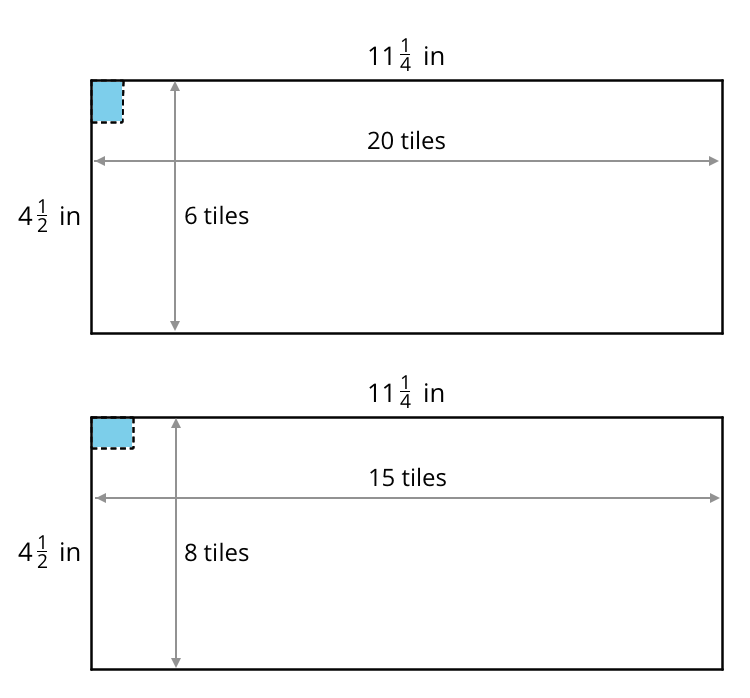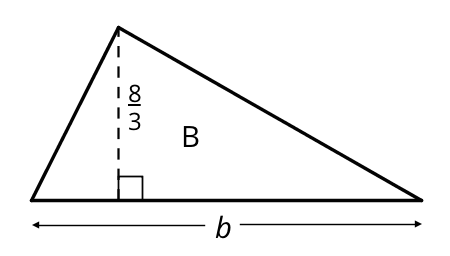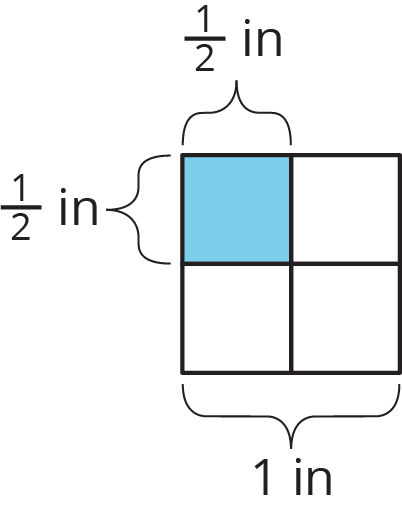Lesson 10
Rectangles and Triangles with Fractional Lengths
10.1: Areas of Squares (5 minutes)
Warm-up
In this warm-up, students review how to find and record the area of a square with whole-number and fractional side lengths. The first question is open-ended to encourage students to notice many things about the area of each square, the relationships between them, and other geometric ideas they might remember from earlier grades. The second question prepares students for the work in this lesson. Focus class discussion on this question.
As students discuss the second question, note those who think of the area of a \(\frac13\)-inch square in terms of:
- Tiling, i.e., determining how many squares with \(\frac13\)-inch side length cover a square with 1-inch side length and dividing the area of 1 square inch by that number
- Multiplying \(\frac13 \boldcdot \frac13\)
Launch
Arrange students in groups of 2. Display the image and the first question for all to see. Give students 1 minute of quiet time to make observations about the squares. Follow with a brief whole-class discussion.
If not mentioned by students, ask students what they notice about the following:
- The area of each square
- How to record the area in square inches
- Whether one square could tile another square completely
Then, give students 1–2 minutes to discuss the second question with their partner.
Student Facing

- What do you notice about the areas of the squares?
- Kiran says “A square with side lengths of \(\frac13\) inch has an area of \(\frac13\) square inches.” Do you agree? Explain or show your reasoning.
Student Response
For access, consult one of our IM Certified Partners.
Anticipated Misconceptions
Some students may struggle in getting started with the second question. Suggest that they try marking up the given 1-inch square to show \(\frac13\)-inch squares.
Activity Synthesis
Consider telling students that we can call a square with 1-inch side length “a 1-inch square.”
Ask previously identified students to share their response to the second question. Illustrate their reasoning for all to see. After each person shares, poll the class on whether they agree with the answer and the explanation. If not mentioned in students’ explanations, highlight the following ideas:
- A square with a side length of 1 inch (a 1-inch square) has an area of 1 in2.
- A 2-inch square has an area of 4 in2, because 4 squares with 1-inch side length are needed to cover it.
- A \(\frac12\)-inch square has an area of \(\frac14\) in2 because 4 of them are needed to completely cover a 1-inch square.
- A \(\frac13\)-inch square has a side length of \(\frac13\) inch, so it would take 9 squares to cover a 1-inch square. Its area is therefore \(\frac19\) square inch.
10.2: How Many Would it Take? (Part 2) (15 minutes)
Activity
This activity consolidates prior work on the area of rectangles and the current work on division of fractions. Students determine how many tiles with fractional side lengths are needed to completely cover another rectangular region that also has fractional side lengths. Besides dividing fractions, students also need to plan their approach, think about how the orientation of the tiles affects their calculation and solution, and attend carefully to the different measurements and steps in their calculation. The experience here prepares students to work with lengths and volumes in the culminating lesson (in which students determine how many small boxes with fractional edge lengths will fit into larger boxes that also have fractional edge lengths).
As students work, identify those whose diagrams or solutions show different tile orientations. Also notice students who consider both ways of laying the tiles before finding the solutions.
Launch
Keep students in groups of 2. Give students 7–8 minutes of quiet work time and 2–3 minutes to share their responses with their partner, or give 10 minutes for them to complete the activity in groups.
Design Principle(s): Support sense-making
Student Facing
Noah would like to cover a rectangular tray with rectangular tiles. The tray has a width of \(11\frac14\) inches and an area of \(50\frac58\) square inches.
- Find the length of the tray in inches.
- If the tiles are \(\frac{3}{4}\) inch by \(\frac{9}{16}\) inch, how many would Noah need to cover the tray completely, without gaps or overlaps? Explain or show your reasoning.
- Draw a diagram to show how Noah could lay the tiles. Your diagram should show how many tiles would be needed to cover the length and width of the tray, but does not need to show every tile.
Student Response
For access, consult one of our IM Certified Partners.
Anticipated Misconceptions
Students might only determine the amount of tiles needed to line the four sides of the tray. If this happens, suggest that they look at their drawing of the tray and check whether their tiles cover the entire area of the tray.
Activity Synthesis
Invite students who chose different tile orientations to show their diagrams and explain their reasoning. Display these two diagrams, if needed.

Point out how in this problem, the two different tile orientations do not matter, as the length and the width of the tiles are factors of both the length and the width of the tray. This means we can fit a whole number of tiles in either direction, and can fit the same number of tiles to cover the tray regardless of orientation.
But if the side lengths of the tiles do not both fit into \(11\frac14\) and \(4\frac12\) evenly, then the orientation of the tiles does matter (i.e., we may need more or fewer tiles, or we may not be able to tile the entire tray without gaps if the tiles are oriented a certain way).
Use the opportunity to point out that a diagram does not have to show all the details (i.e., every single tile) to be useful.
10.3: Bases and Heights of Triangles (15 minutes)
Activity
In this activity, students apply their knowledge of division of fractions to answer questions about bases and heights of triangles, which they studied earlier in the year. In the first question, students recal how to find the area of a triangle given a pair of base and height. Next, they find a missing length given the area of a triangle and a fractional base or height.
The formula for the area of a triangle \(A = \frac12 \boldcdot b \boldcdot h\) presents a different multiplication situation than students have seen in this unit—there are three factors at play. Students are likely to approach in a number of ways. They may:
- Draw a duplicate of the triangle and compose a parallelogram with the same base and height, double the given area (to represent the area of the parallelogram), and then divide by the known length to find the unknown length
- Without drawing, multiply the given area by 2 to find the value of \(b \boldcdot h\), and then divide it by the known length
- Perform division twice, i.e., dividing the area by \(\frac12\) and then by the known base or length, or vice versa
- Multiply the known length and \(\frac12\) first, so there are only two factors to work with (e.g., for \(\frac12 \boldcdot b \boldcdot \frac83 = 8\), they may apply the commutative and associative properties of operations and write \(\frac12 \boldcdot \frac83 \boldcdot b = 8\) and then \(\frac43 \boldcdot b = 8\))
Monitor for these or other approaches as students work. Select students who use different strategies to share later.
Launch
Arrange students in groups of 2. Give students 2 minutes of quiet work time, followed by 1 minute of partner discussion. Before students begin, review the formula for the area of a triangle. Consider displaying a drawing of a triangle with one side labeled as a base and a corresponding height shown and labeled as such.
Keep students in groups of 2. Give students 4–5 minutes of quiet work time and 2 minutes to discuss their responses and complete the activity with their partner. Keep the formula for the area of a triangle and a labeled drawing of a triangle displayed.
Action and Expression: Develop Expression and Communication. Activate or supply background knowledge. During the launch, take time to review the following terms from previous lessons that students will need to access for this activity: base and height of a triangle, formula for area of a triangle.
Supports accessibility for: Memory; Language
Student Facing
-
Find the area of Triangle A in square centimeters. Show your reasoning.

-
The area of Triangle B is 8 square units. Find the length of \(b\). Show your reasoning.

-
The area of Triangle C is \(\frac{54}{5}\) square units. What is the length of \(h\)? Show your reasoning.

Student Response
For access, consult one of our IM Certified Partners.
Anticipated Misconceptions
Activity Synthesis
Ask previously selected students to share their solutions and reasoning. Sequence their presentations so that students who reasoned concretely (e.g., by duplicating the triangle to compose a parallelogram) present first and those who reasoned symbolically (e.g., only by manipulating expressions or equations) present last. After each student shares, ask all students to indicate whether they reasoned the same way.
Clarify that there is no single way to solve problems such as these. Point out specific points in the solving process where division of fractions enabled them to complete their reasoning. Emphasize that what we learned about fractions and operations in this unit can help us reason more effectively about problems in other areas of mathematics.
Speaking: MLR8 Discussion Supports. Use this to routine amplify students' use of mathematical language to communicate reasoning about finding the area of triangles. When students share their solutions and reasoning, remind them to use words such as compose, quadrilateral, parallelogram, base, height, area, and rearrange. Invite students to chorally repeat the phrases that include these words in context. Students used these words in a previous unit, so this will help students be more precise with their language.
Design Principle(s): Optimize output (for explanation)
Lesson Synthesis
Lesson Synthesis
Emphasize that because we can multiply the side lengths of a rectangle (even if they are not whole numbers) to find its area, if we know the area of a rectangle and one side length, we can find the length of the other side by dividing.
- “Suppose we know that the width of a rectangle is \(4 \frac{3}{5}\) cm and the area is \(16\frac{1}{10}\) sq cm. How can we find its length?” (We can find \(16\frac{1}{10} \div 4\frac{3}{5} = ?\))
- “How do we check our quotient?” (We can multiply it by the width \(4\frac{3}{5}\) and see if we get the given area.)
We can also use the connections between area, height, and base of a triangle to find unknown information.
- “How is finding an unknown base or height in a triangle different than finding an unknown side length in a rectangle?” (In a triangle, there are three factors at play.)
- “What multiplication equation can we write to help us find the height of a triangle that has a base of \(\frac{5}{4}\) cm and an area of 10 sq cm?” (\(\frac{1}{2} \boldcdot \frac{5}{4} \boldcdot h = 10\).)
- “How do we go about finding the unknown length?” (We can multiply the two known factors first. In this case, we can multiply \(\frac{1}{2} \boldcdot \frac{5}{4}\) to get \(\frac{5}{8}\), and then divide 10 by \(\frac{5}{8}\). Or we can divide by the factors one at a time—divide by \(\frac{1}{2}\) first, and then by \(\frac{5}{4}\).)
10.4: Cool-down - Two Frames (5 minutes)
Cool-Down
For access, consult one of our IM Certified Partners.
Student Lesson Summary
Student Facing
If a rectangle has side lengths \(a\) units and \(b\) units, the area is \(a \boldcdot b\) square units. For example, if we have a rectangle with \(\frac12\)-inch side lengths, its area is \(\frac12 \boldcdot \frac12\) or \(\frac14\) square inches.

This means that if we know the area and one side length of a rectangle, we can divide to find the other side length.

If one side length of a rectangle is \(10\frac12\) in and its area is \(89\frac14\) in2, we can write this equation to show their relationship: \(\displaystyle 10\frac12 \boldcdot {?} =89\frac14\)
Then, we can find the other side length, in inches, using division: \(\displaystyle 89\frac14 \div 10\frac12 = {?}\)